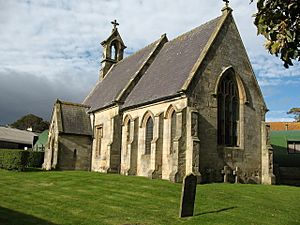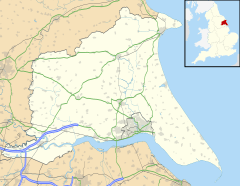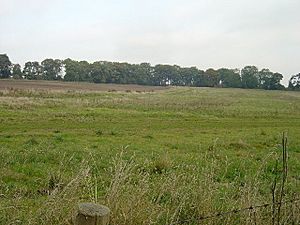Cowlam facts for kids
Quick facts for kids Cowlam |
|
|---|---|
 St Mary's Church, Cowlam |
|
| OS grid reference | SE965655 |
| • London | 175 mi (282 km) S |
| Civil parish | |
| Unitary authority | |
| Ceremonial county | |
| Region | |
| Country | England |
| Sovereign state | United Kingdom |
| Post town | DRIFFIELD |
| Postcode district | YO25 |
| Dialling code | 01377 |
| Police | Humberside |
| Fire | Humberside |
| Ambulance | Yorkshire |
| EU Parliament | Yorkshire and the Humber |
| UK Parliament |
|
Cowlam is a tiny village, called a hamlet, in the East Riding of Yorkshire, England. It's located in an area known as the Yorkshire Wolds. You can find Cowlam on the B1253 road, which connects Bridlington to North Grimston. It's about 17 miles (27 km) north of Beverley, which is the main town of the county. Cowlam is also close to the village of Sledmere (about 2 miles or 3 km east) and the hamlet of Cottam (about 2.5 miles or 4 km north-west). Today, Cowlam has only eight houses and two farms.
A Look Back in Time
Cowlam has a long history! In ancient times, it was known by names like 'Colume' and 'Coleham'. When the famous Domesday Book was written in 1086, Cowlam was called 'Colnun'. The Domesday Book was a huge survey ordered by William the Conqueror to record who owned what in England after he became king.
Back in 1066, before William the Conqueror arrived, a person named Ketilbert was the 'lord' of Cowlam. This meant he was in charge of the land and people there. After William I took over England, Cowlam became his property.
Cowlam was once a Bronze Age encampment, which was like an old fort. You can still see signs of this ancient settlement in the ground, about half a mile (0.8 km) from the current hamlet. Later, there was a medieval village here. However, this village became empty, or deserted, in the late 1600s.
In 1931, the area of Cowlam had 47 people living there. But on April 1, 1935, Cowlam joined with the nearby area of Cottam.
St Mary's Church
The church of St Mary at Cowlam is a very old building. It's one of the churches on the Sykes Churches Trail, which is a route that visits several historic churches. This small church was built in the medieval period, meaning it's hundreds of years old. It has a special baptismal font (a basin used for baptisms) that is from the Norman period, which is even older!
The church was repaired and updated in 1852. The design for this work was created by Mary E. Sykes. In 1966, St Mary's Church was given a special status called Grade II listed building. This means it's an important historic building that needs to be protected. It is now officially recorded in the National Heritage List for England.



